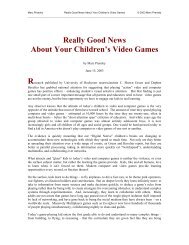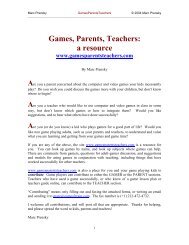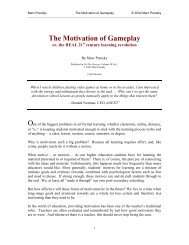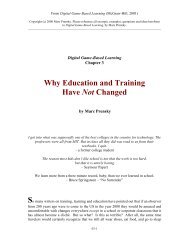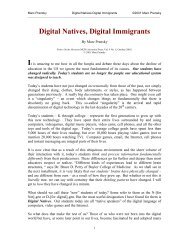Do They Really Think Differently? - Marc Prensky
Do They Really Think Differently? - Marc Prensky
Do They Really Think Differently? - Marc Prensky
Create successful ePaper yourself
Turn your PDF publications into a flip-book with our unique Google optimized e-Paper software.
<strong>Marc</strong> <strong>Prensky</strong> <strong>Do</strong> <strong>They</strong> <strong>Really</strong> <strong>Think</strong> <strong>Differently</strong>? ©2001 <strong>Marc</strong> <strong>Prensky</strong><br />
_____________________________________________________________________________________<br />
Digital Natives, Digital Immigrants, Part II:<br />
<strong>Do</strong> <strong>They</strong> <strong>Really</strong> <strong>Think</strong> <strong>Differently</strong>?<br />
By <strong>Marc</strong> <strong>Prensky</strong><br />
Published in On the Horizon (NCB University Press, Vol. 9 No. 6, December 2001)<br />
© 2001 <strong>Marc</strong> <strong>Prensky</strong><br />
Different kinds of experiences lead to different brain structures.<br />
-Dr. Bruce D. Berry, Baylor College of Medicine<br />
Our children today are being socialized in a way that is vastly different from their parents. The<br />
numbers are overwhelming: over 10,000 hours playing videogames, over 200,000 emails and<br />
instant messages sent and received; over 10,000 hours talking on digital cell phones; over 20,000<br />
hours watching TV (a high percentage fast speed MTV), over 500,000 commercials seen—all<br />
before the kids leave college. And, maybe, at the very most, 5,000 hours of book reading. These<br />
are today’s ―Digital Native‖ students. 1<br />
In Digital Natives, Digital Immigrants: Part I, I discussed how the differences between our Digital<br />
Native students and their Digital Immigrant teachers lie at the root of a great many of today’s<br />
educational problems. I suggested that Digital Natives’ brains are likely physically different as a<br />
result of the digital input they received growing up. And I submitted that learning via digital<br />
games is one good way to reach Digital Natives in their ―native language.‖<br />
Here I present evidence for why I think this is so. It comes from neurobiology, social psychology,<br />
and from studies done on children using games for learning.<br />
Neuroplasticity<br />
Although the vast majority of today’s educators and teachers grew up with the understanding that<br />
the human brain doesn’t physically change based on stimulation it receives from the outside—<br />
especially after the age of 3— it turns out that that view is, in fact, incorrect.<br />
Based on the latest research in neurobiology, there is no longer any question that stimulation of<br />
various kinds actually changes brain structures and affects the way people think, and that these<br />
transformations go on throughout life. The brain is, to an extent not at all understood or believed<br />
to be when Baby Boomers were growing up, massively plastic. It can be, and is, constantly
<strong>Marc</strong> <strong>Prensky</strong> <strong>Do</strong> <strong>They</strong> <strong>Really</strong> <strong>Think</strong> <strong>Differently</strong>? ©2001 <strong>Marc</strong> <strong>Prensky</strong><br />
_____________________________________________________________________________________<br />
reorganized. (Although the popular term rewired is somewhat misleading, the overall idea is<br />
right—the brain changes and organizes itself differently based on the inputs it receives.) The old<br />
idea that we have a fixed number of brain cells that die off one by one has been replaced by<br />
research showing that our supply of brain cells is replenished constantly. 2 The brain constantly<br />
reorganizes itself all our child and adult lives, a phenomenon technically known as neuroplasticity.<br />
One of the earliest pioneers in this field of neurological research found that rats in ―enriched‖<br />
environments showed brain changes compared with those in ―impoverished‖ environments after as<br />
little as two weeks. Sensory areas of their brains were thicker, other layers heavier. Changes<br />
showed consistent overall growth, leading to the conclusion that the brain maintains its plasticity<br />
for life. 3<br />
Other experiments leading to similar conclusions include the following:<br />
� Ferrets’ brains were physically rewired, with inputs from the eyes switched to where the<br />
hearing nerves went and vice versa. Their brains changed to accommodate the new inputs. 4<br />
� Imaging experiments have shown that when bind people learn Braille, ―visual‖ areas of their<br />
brains lit up. Similarly, deaf people use their auditory cortex to read signs. 5<br />
� Scans of brains of people who tapped their fingers in a complicated sequence that they had<br />
practiced for weeks showed a larger area of motor cortex becoming activated then when they<br />
performed sequences they hadn’t practiced. 6<br />
� Japanese subjects were able learn to ―reprogram‖ their circuitry for distinguishing ―ra‖ from<br />
―la,‖ a skill they ―forget‖ soon after birth because their language doesn’t require it. 7<br />
� Researchers found that an additional language learned later in life goes into a different place in<br />
the brain than the language or languages learned as children. 8<br />
� Intensive reading instruction experiments with students aged 10 and up appeared to create<br />
lasting chemical changes in key areas of the subjects’ brains. 9<br />
� A comparison of musicians versus nonplayers brains via magnetic resonance imaging showed<br />
a 5 percent greater volume in the musicians’ cerebellums, ascribed to adaptations in the brain’s<br />
structure resulting from intensive musical training and practice. 10<br />
We are only at the very beginning of understanding and applying brain plasticity research. The<br />
goal of many who are—such as the company Scientific Learning—is ―neuroscience-based<br />
education.‖ 11<br />
Malleability<br />
Social psychology also provides strong evidence that one’s thinking patterns change depending on<br />
one’s experiences. Until very recently Western philosophers and psychologists took it for granted<br />
that the same basic processes underlie all human thought. While cultural differences might dictate<br />
what people think about, the strategies and processes of thought, which include logical reasoning<br />
and a desire to understand situations and events in linear terms of cause and effect, were assumed<br />
to be the same for everyone. However this, too, appears to be wrong.
<strong>Marc</strong> <strong>Prensky</strong> <strong>Do</strong> <strong>They</strong> <strong>Really</strong> <strong>Think</strong> <strong>Differently</strong>? ©2001 <strong>Marc</strong> <strong>Prensky</strong><br />
_____________________________________________________________________________________<br />
Research by social psychologists 12 shows that people who grow up in different cultures do not just<br />
think about different things, they actually think differently. The environment and culture in which<br />
people are raised affects and even determines many of their thought processes.<br />
―We used to think that everybody uses categories in the same way, that logic plays the same kind<br />
of role for everyone in the understanding of everyday life, that memory, perception, rule<br />
application and so on are the same,‖ says one. ―But we’re now arguing that cognitive processes<br />
themselves are just far more malleable than mainstream psychology assumed.‖ 13<br />
We now know that brains that undergo different developmental experiences develop differently,<br />
and that people who undergo different inputs from the culture that surrounds them think<br />
differently. And while we haven’t yet directly observed Digital Natives’ brains to see whether they<br />
are physically different (such as musicians’ appear to be) the indirect evidence for this is extremely<br />
strong.<br />
However, brains and thinking patterns do not just change overnight. A key finding of brain<br />
plasticity research is that brains do not reorganize casually, easily, or arbitrarily. ―Brain<br />
reorganization takes place only when the animal pays attention to the sensory input and to the<br />
task.‖ 14 ―It requires very hard work.‖ 15 Biofeedback requires upwards of 50 sessions to produce<br />
results. 16 Scientific Learning’s Fast ForWard program requires students to spend 100 minutes a<br />
day, 5 days a week, for 5 to 10 weeks to create desired changes, because ―it takes sharply focused<br />
attention to rewire a brain.‖ 17<br />
Several hours a day, five days a week, sharply focused attention—does that remind you of<br />
anything? Oh, yes—video games! That is exactly what kids have been doing ever since Pong<br />
arrived in 1974. <strong>They</strong> have been adjusting or programming their brains to the speed, interactivity,<br />
and other factors in the games, much as boomers’ brains were programmed to accommodate<br />
television, and literate man’s brains were reprogrammed to deal with the invention of written<br />
language and reading (where the brain had to be retrained to deal with things in a highly linear<br />
way.) 18 ―Reading does not just happen, it is a terrible struggle.‖ 19 ―Reading [has] a different<br />
neurology to it than the things that are built into our brain, like spoken language.‖ 20 One of the<br />
main focuses of schools for the hundreds of years since reading became a mass phenomenon has<br />
been retraining our speech-oriented brains to be able to read. Again, the training involves several<br />
hours a day, five days a week, and sharply focused attention.<br />
Of course just when we’d figured out (more or less) how to retrain brains for reading, they were<br />
retrained again by television. And now things have changed yet again, and our children are<br />
furiously retraining their brains in even newer ways, many of which are antithetical to our older<br />
ways of thinking.<br />
Children raised with the computer ―think differently from the rest of us. <strong>They</strong> develop hypertext<br />
minds. <strong>They</strong> leap around. It’s as though their cognitive structures were parallel, not sequential.‖ 21<br />
―Linear thought processes that dominate educational systems now can actually retard learning for<br />
brains developed through game and Web-surfing processes on the computer.‖ 22
<strong>Marc</strong> <strong>Prensky</strong> <strong>Do</strong> <strong>They</strong> <strong>Really</strong> <strong>Think</strong> <strong>Differently</strong>? ©2001 <strong>Marc</strong> <strong>Prensky</strong><br />
_____________________________________________________________________________________<br />
Some have surmised that teenagers use different parts of their brain and think in different ways<br />
than adults when at the computer. 23 We now know that it goes even further—their brains are<br />
almost certainly physiologically different. But these differences, most observers agree, are less a<br />
matter of kind than a difference of degree. For example as a result of repeated experiences,<br />
particular brain areas are larger and more highly developed, and others are less so.<br />
For example, thinking skills enhanced by repeated exposure to computer games and other digital<br />
media include reading visual images as representations of three-dimensional space<br />
(representational competence), multidimensional visual-spatial skills, mental maps, ―mental paper<br />
folding‖ (i.e. picturing the results of various origami-like folds in your mind without actually doing<br />
them), ―inductive discovery‖ (i.e. making observations, formulating hypotheses and figuring out<br />
the rules governing the behavior of a dynamic representation), ―attentional deployment‖ (such as<br />
monitoring multiple locations simultaneously), and responding faster to expected and unexpected<br />
stimuli. 24<br />
While these individual cognitive skills may not be new, the particular combination and intensity is.<br />
We now have a new generation with a very different blend of cognitive skills than its<br />
predecessors—the Digital Natives.<br />
What About Attention Spans?<br />
We hear teachers complain so often about the Digital Natives’ attention spans that the phrase ―the<br />
attention span of a gnat‖ has become a cliché. But is it really true?<br />
―Sure they have short attention spans—for the old ways of learning,‖ says a professor. 25 Their<br />
attention spans are not short for games, for example, or for anything else that actually interests<br />
them. As a result of their experiences Digital Natives crave interactivity—an immediate response<br />
to their each and every action. Traditional schooling provides very little of this compared to the<br />
rest of their world (one study showed that students in class get to ask a question every 10 hours) 26<br />
So it generally isn’t that Digital Natives can’t pay attention, it’s that they choose not to.<br />
Research done for Sesame Street reveals that children do not actually watch television<br />
continuously, but ―in bursts.‖ <strong>They</strong> tune in just enough to get the gist and be sure it makes sense.<br />
In one key experiment, half the children were shown the program in a room filled with toys. As<br />
expected, the group with toys was distracted and watched the show only about 47 percent of the<br />
time as opposed to 87 percent in the group without toys. But when the children were tested for<br />
how much of the show they remembered and understood, the scores were exactly the same. ―We<br />
were led to the conclusion that the 5-year-olds in the toys group were attending quite strategically,<br />
distributing their attention between toy play and viewing so that they looked at what was for them<br />
the most informative part of the program. The strategy was so effective that the children could<br />
gain no more from increased attention.‖ 27<br />
What Have We Lost?<br />
Comment [SA1]:
<strong>Marc</strong> <strong>Prensky</strong> <strong>Do</strong> <strong>They</strong> <strong>Really</strong> <strong>Think</strong> <strong>Differently</strong>? ©2001 <strong>Marc</strong> <strong>Prensky</strong><br />
_____________________________________________________________________________________<br />
Still, we often hear from teachers about increasing problems their students have with reading and<br />
thinking. What about this? Has anything been lost in the Digital Natives’ ―reprogramming‖<br />
process?<br />
One key area that appears to have been affected is reflection. Reflection is what enables us,<br />
according to many theorists, to generalize, as we create ―mental models‖ from our experience. It<br />
is, in many ways, the process of ―learning from experience.‖ In our twitch-speed world, there is<br />
less and less time and opportunity for reflection, and this development concerns many people. One<br />
of the most interesting challenges and opportunities in teaching Digital Natives is to figure out and<br />
invent ways to include reflection and critical thinking in the learning (either built into the<br />
instruction or through a process of instructor-led debriefing) but still do it in the Digital Native<br />
language. We can and must do more in this area.<br />
Digital Natives accustomed to the twitch-speed, multitasking, random-access, graphics-first,<br />
active, connected, fun, fantasy, quick-payoff world of their video games, MTV, and Internet are<br />
bored by most of today’s education, well meaning as it may be. But worse, the many skills that<br />
new technologies have actually enhanced (e.g., parallel processing, graphics awareness, and<br />
random access)—which have profound implications for their learning—are almost totally ignored<br />
by educators.<br />
The cognitive differences of the Digital Natives cry out for new approaches to education with a<br />
better ―fit.‖ And, interestingly enough, it turns out that one of the few structures capable of<br />
meeting the Digital Natives’ changing learning needs and requirements is the very video and<br />
computer games they so enjoy. This is why ―Digital Game-Based Learning‖ is beginning to<br />
emerge and thrive.<br />
But <strong>Do</strong>es It Work?<br />
Of course many criticize today’s learning games, and there is much to criticize. But if some of<br />
these games don’t produce learning it is not because they are games, or because the concept of<br />
―game-based learning‖ is faulty. It’s because those particular games are badly designed. There is<br />
a great deal of evidence that children’s learning games that are well designed do produce learning,<br />
and lots of it — by and while engaging kids.<br />
While some educators refer to games as ―sugar coating,‖ giving that a strongly negative<br />
connotation—and often a sneer—it is a big help to the Digital Natives. After all, this is a medium<br />
they are very familiar with and really enjoy.<br />
Elementary school, when you strip out the recesses and the lunch and the in-between times,<br />
actually consists of about three hours of instruction time in a typical 9 to 3 day. 28 So assuming, for<br />
example, that learning games were only 50% educational, if you could get kids to play them for six<br />
hours over a weekend, you’d effectively add a day a week to their schooling! Six hours is far less<br />
than a Digital Native would typically spend over a weekend watching TV and playing videogames.<br />
The trick, though, is to make the learning games compelling enough to actually be used in their
<strong>Marc</strong> <strong>Prensky</strong> <strong>Do</strong> <strong>They</strong> <strong>Really</strong> <strong>Think</strong> <strong>Differently</strong>? ©2001 <strong>Marc</strong> <strong>Prensky</strong><br />
_____________________________________________________________________________________<br />
place. <strong>They</strong> must be real games, not just drill with eye-candy, combined creatively with real<br />
content.<br />
The numbers back this up. The Lightspan Partnership, which created PlayStation games for<br />
curricular reinforcement, conducted studies in over 400 individual school districts and a ―metaanalysis‖<br />
as well. Their findings were increases in vocabulary and language arts of 24 and 25<br />
percent respectively over the control groups, while the math problem solving and math procedures<br />
and algorithms scores were 51 and 30 percent higher. 29<br />
Click Health, which makes games to help kids self-manage their health issues, did clinical trials<br />
funded by the National Institutes of Health. <strong>They</strong> found, in the case of diabetes, that kids playing<br />
their games (as compared to a control group playing a pinball game) showed measurable gains in<br />
self-efficacy, communication with parents and diabetes self-care. And more importantly, urgent<br />
doctor visits for diabetes-related problems declined 77 percent in the treatment group. 30<br />
Scientific Learning’s Fast ForWard game-based program for retraining kids with reading<br />
problems conducted National Field Trials using 60 independent professionals at 35 sites across the<br />
US and Canada. Using standardized tests, each of the 35 sites reported conclusive validation of the<br />
program’s effectiveness, with 90 percent of the children achieving significant gains in one or more<br />
tested areas. 31<br />
Again and again it’s the same simple story. Practice—time spent on learning—works. Kid’s don’t<br />
like to practice. Games capture their attention and make it happen. And of course they must be<br />
practicing the right things, so design is important.<br />
The US military, which has a quarter of a million 18-year-olds to educate every year, is a big<br />
believer in learning games as a way to reach their Digital Natives. <strong>They</strong> know their volunteers<br />
expect this: ―If we don’t do things that way, they’re not going to want to be in our environment.‖ 32<br />
What’s more, they've observed it working operationally in the field. ―We’ve seen it time and time<br />
again in flying airplanes, in our mission simulators.‖ Practical-minded Department of Defense<br />
trainers are perplexed by educators who say ―We don’t know that educational technology works—<br />
we need to do some more studies.‖ ―We KNOW the technology works,‖ they retort. We just want<br />
to get on with using it.‖ 33<br />
__________<br />
So, today’s neurobiologists and social psychologists agree that brains can and do change with new<br />
input. And today’s educators with the most crucial learning missions—teaching the handicapped<br />
and the military—are already using custom designed computer and video games as an effective<br />
way of reaching Digital Natives. But the bulk of today’s tradition-bound educational<br />
establishment seem in no hurry to follow their lead.<br />
Yet these educators know something is wrong, because they are not reaching their Digital Native<br />
students as well as they reached students in the past. So they face an important choice.
<strong>Marc</strong> <strong>Prensky</strong> <strong>Do</strong> <strong>They</strong> <strong>Really</strong> <strong>Think</strong> <strong>Differently</strong>? ©2001 <strong>Marc</strong> <strong>Prensky</strong><br />
_____________________________________________________________________________________<br />
On the one hand, they can choose to ignore their eyes, ears and intuition, pretend the Digital<br />
Native/Digital Immigrant issue does not exist, and continue to use their suddenly-much-lesseffective<br />
traditional methods until they retire and the Digital Natives take over.<br />
Or they can chose instead to accept the fact that they have become Immigrants into a new Digital<br />
world, and to look to their own creativity, their Digital Native students, their sympathetic<br />
administrators and other sources to help them communicate their still-valuable knowledge and<br />
wisdom in that world’s new language.<br />
The route they ultimately choose—and the education of their Digital Native students—depends<br />
very much on us.<br />
<strong>Marc</strong> <strong>Prensky</strong> is an internationally acclaimed speaker, writer, consultant, and designer in the critical areas of<br />
education and learning. He is the author of Digital Game-Based Learning (McGraw Hill, 2001.) He is founder and<br />
CEO of Games2train, a game-based learning company; founder of The Digital Multiplier, an organization dedicated<br />
to eliminated the digital divide in learning worldwide; and creator of the site www.SocialImpactGames.com. Mr.<br />
<strong>Prensky</strong> holds an MBA from Harvard and a Masters in Teaching from Yale. More of <strong>Marc</strong>’s writings can be found at<br />
www.marcprensky.com/writing/default.asp . He can be contacted at marc@games2train.com
<strong>Marc</strong> <strong>Prensky</strong> <strong>Do</strong> <strong>They</strong> <strong>Really</strong> <strong>Think</strong> <strong>Differently</strong>? ©2001 <strong>Marc</strong> <strong>Prensky</strong><br />
_____________________________________________________________________________________<br />
Notes<br />
1. These numbers are intended purely as ―order of magnitude‖ approximations; they obviously vary widely for<br />
individuals. <strong>They</strong> were arrived at in the following ways ( Note: I am very interested in any additional data anyone has<br />
on this):<br />
Videogames: Average play time: 1.5 hours/day (Source: ―Interactive Videogames, Mediascope, June 1996.) It is<br />
likely to be higher five years later, so 1.8 x 365 x 15 years = 9,855 hours.<br />
E-mails and Instant Messages: Average 40 per day x 365 x 15 years = 219, 000. This is not unrealistic even for<br />
pre-teens – in just one instant messaging connection there may be over 100 exchanges per day – and most people<br />
do multiple connections.<br />
TV: ―Television in the Home, 1998: Third Annual Survey of Parent and Children, Annenburg Policy Center, June<br />
22, 1998, gives the number of TV hours watched per day as 2.55. M. Chen, in the Smart Parents Guide to Kid’s<br />
TV, (1994) gives the number as 4 hours/day. Taking the average, 3.3 hrs/day x 365 days x 18 years = 21,681.<br />
Commercials: There are roughly 18 30-second commercials during a TV hour. 18 commercials/hour x 3.3<br />
hours/day x 365 days x 20 years (infants love commercials) = 433,620.<br />
Reading: Eric Leuliette, a voracious (and meticulous) reader who has listed online every book he has ever read<br />
(www.csr.utexas.edu/personal/leuliette/fw_table_home.html), read about 1300 books through college. If we take<br />
1300 books x 200 pages per book x 400 words per page, we get 10,400,000,000 words. Read at 400 words/that<br />
gives 260,000 minutes, or 4,333 hours. This represents a little over 3 hours/book. Although others may read<br />
more slowly, most have read far fewer books than Leuliette.<br />
2. Paul Perry in American Way, May 15, 2000.<br />
3. Renate Numella Caine and Geoffrey Caine, Making Connections: Teaching and the Human Brain,<br />
Addison-Wesley, 1991, p.31.<br />
4. Dr. Mriganka Sur, Nature, April 20, 2000.<br />
5. Sandra Blakeslee, New York Times, April 24, 2000.<br />
6. Leslie Ungerlieder, National Institutes of Health.<br />
7. James McLelland, University of Pittsburgh.<br />
8. Cited in Inferential Focus Briefing, September 30, 1997.<br />
9. Virginia Berninger, University of Washington, American Journal of Neuroradiology, May 2000.<br />
10. Dr. Mark Jude Tramano of Harvard. Reported in USA Today December 10, 1998.<br />
11. Newsweek, January 1, 2000.<br />
12. <strong>They</strong> include Alexandr Romanovich Luria (1902-1977), Soviet pioneer in neuropsychology, author of The Human<br />
Brain and Psychological Processes (1963), and, more recently, Dr. Richard Nisbett of the University of<br />
Michigan.<br />
13. Quoted in Erica Goode, ―How Culture Molds Habits of Thought,‖ New York Times, August 8, 2000.<br />
14. John T. Bruer, The Myth of the First Three Years, The Free Press, 1999, p. 155.
<strong>Marc</strong> <strong>Prensky</strong> <strong>Do</strong> <strong>They</strong> <strong>Really</strong> <strong>Think</strong> <strong>Differently</strong>? ©2001 <strong>Marc</strong> <strong>Prensky</strong><br />
_____________________________________________________________________________________<br />
15. G. Ried Lyon, a neuropsychologist who directs reading research funded by the National Institutes of Health,<br />
quoted in Frank D. Roylance ―Intensive Teaching Changes Brain,‖ SunSpot, Maryland’s Online Community, May<br />
27, 2000.<br />
16. Alan T. Pope, research psychologist, Human Engineering Methods, NASA. Private communication.<br />
17. Time, July 5, 1999.<br />
18. The Economist, December 6, 1997.<br />
19. Kathleen Baynes, neurology researcher, University of California – Davis, quoted in Robert Lee Hotz ―In Art of<br />
Language, the Brain Matters ― Los Angeles Times, October 18, 1998.<br />
20. Dr. Michael S. Gazzaniga, neuroscientist at Dartmouth College quoted in Robert Lee Hotz ―In Art of Language,<br />
the Brain Matters ― Los Angeles Times, October 18, 1998.<br />
21. William D. Winn, Director of the Learning Center, Human Interface Technology Laboratory, University of<br />
Washington, quoted in Moore, Inferential Focus Briefing (see 22).<br />
22. Peter Moore, Inferential Focus Briefing, September 30, 1997.<br />
23. Ibid.<br />
24. Patricia Marks Greenfield, Mind and Media, The Effects of Television, Video Games and Computers, Harvard<br />
University Press, 1984.<br />
25. Dr. Edward Westhead, professor of biochemistry (retired), University of Massachusetts.<br />
26. Graesser, A.C., & Person, N.K. (1994) ―Question asking during tutoring,‖. American Educational Research<br />
Journal, 31, 104-107.<br />
27. Elizabeth Lorch, psychologist, Amherst College, quoted in Malcolm Gladwell, The Tipping Point: How Little<br />
Things Can Make a Big Difference, Little Brown & Company, 2000, p. 101.<br />
28. John Kernan, President, The Lightspan Partnership. Personal communication.<br />
29. ―Evaluation of Lightspan. Research Results from 403 schools and over 14,580 students,‖ February 2000, CD<br />
ROM.<br />
30. Debra A. Lieberman, ―Health Education Video Games for Children and Adolescents: Theory, Design and<br />
Research Findings,‖ paper presented at the annual meeting of the International Communications Association,<br />
Jerusalem, 1998.<br />
31. Scientific Learning Corporation, National Field Trial Results (pamphlet.) See also Merzenich et al., ―Temporal<br />
Processing Deficits of language-Learning Impaired Children Ameliorated by Training‖ and Tallal, et al.,<br />
―Language Comprehension in Language Learning Impaired Children Improved with Acoustically Modified<br />
Speech,‖ in Science, Vol. 271, January 5, 1996, pp 27-28 & 77-84.<br />
32. Michael Parmentier, Director, Office of Readiness and Training, Department of Defense, The Pentagon. Private<br />
briefing.<br />
33. <strong>Do</strong>n Johnson, Office of Readiness and Training, Department of Defense, The Pentagon. Private briefing.





